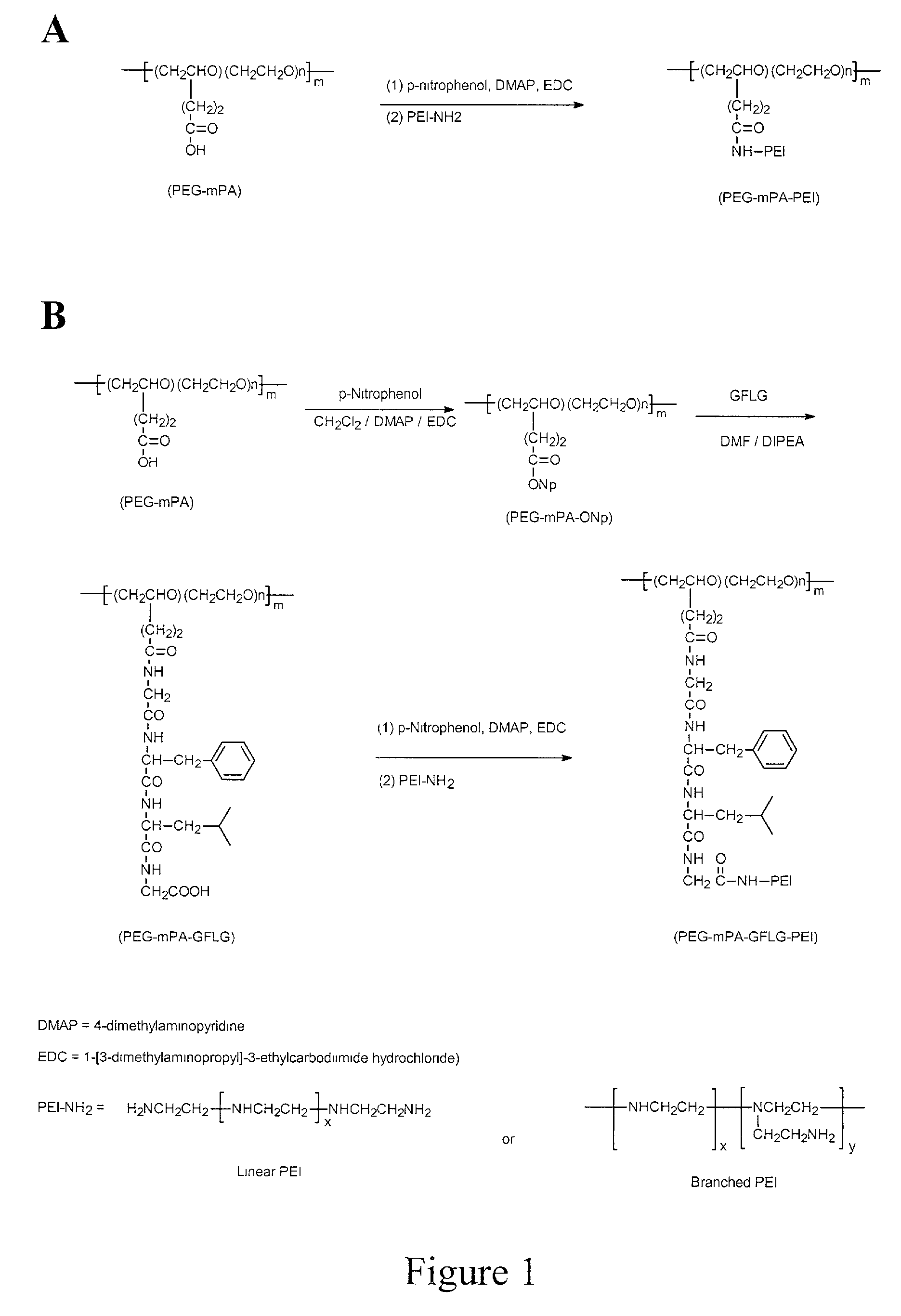Polycationic water soluble copolymer and method for transferring polyanionic macromolecules across biological barriers
a polyanionic macromolecule and polyanionic technology, applied in the direction of drug compositions, immunological disorders, medical preparations, etc., can solve the problems of large pharmaceutical problems, not reaching the desired site, and affecting the clearance of the body, and reducing the effect of oxidative stress
- Summary
- Abstract
- Description
- Claims
- Application Information
AI Technical Summary
Benefits of technology
Problems solved by technology
Method used
Image
Examples
example 1
Synthesis of PEG20K-15PA-PEI400 (15 PEI400 grafted PEG-20K)
[0055]A dry 50 ml one necked flask was charged with 1.3 g of polyethylene glycol of mean molecular weight of about 20,000 with 15 pendant propionic acid groups (PEG20K-15PA) (˜0.75 mmole pendant —COOH, dried overnight in vacuum in P2O5 desiccator) and 10 ml anhydrous dichloromethane with the protection of argon. About 0.15 g (1.1 mmoles) of p-nitrophenol and about 0.015 g of 4-dimethylaminopyridine were added to the flask. The mixture was stirred at room temperature to form a clear solution. Then about 0.20 g (1.0 mmoles)of fine powdered 1-[3-dimethylaminopropyl]-3-ethylcarbodiimide hydrochloride (EDC) was added in one portion. The mixture was again stirred for about 2 hours at room temperature following the dissolution of EDC. Then about 0.18 ml (3.2 mmoles) of acetic acid was added to the clear mixture. The mixture was stirred for an additional 30 minutes at room temperature. The clear reaction mixture was mixed with a sol...
example 2
Synthesis of PEG20K-15PA-PEI800 (15 PEI 800 grafted PEG20K)
[0056]Following the procedure of Example 1, 1.0 g of polyethylene glycol of mean molecular weight of about 20,000 with about 15 pendant propionic acid groups (PEG20K-15PA) reacted with polyethylenimine of mean molecular weight of about 800 (PEI800, 20 grams) to produce about 1.1 grams of PEI20K-15PA-PEI800. 1H-NMR analysis indicates that the copolymer contains about 30% (w / w) PEI, indicating that the average molecular weight of the copolymer is about 28,400, assuming the average molecular weight of the starting PEG15PA is 20,000. 1H-NMR (D2O, 400 MHz), •3.4–3.8 (m, 100 (arbitrarily set), —CH2CH2O— of PEG), 2.4–3.2 (m, 43.0, —CH2CH2N— of PEI).
example 3
Synthesis of PEG20K-8PA-PEI800 (8 PEI 800 grafted PEG-20K)
[0057]Following the procedure of Example 1, 1.0 gram of polyethylene glycol of mean molecular weight of about 20,000 with about 8 pendant propionic acid groups (PEG20K-8PA) reacted with polyethylenimine of mean molecular weight of about 800 (PEI800,20 grams) to produce about 1.2 grams of PEI20K-8PA-PEI800. 1H-NMR analysis indicates that the copolymer contains about 11.5% (w / w) PEI, which indicating that the average molecular weight of the copolymer is about 22,607, assuming the average molecular weight of the starting PEG-8PA is 20,000. 1H-NMR (D2O, 400 MHz), •3.4–3.8 (m, 100 (arbitrarily set), —CH2CH2O— of PEG), 2.4–3.2 (m, 13.3, —CH2CH2N— of PEI).
PUM
| Property | Measurement | Unit |
|---|---|---|
| Mass | aaaaa | aaaaa |
| Mass | aaaaa | aaaaa |
| Mass | aaaaa | aaaaa |
Abstract
Description
Claims
Application Information
 Login to View More
Login to View More - R&D
- Intellectual Property
- Life Sciences
- Materials
- Tech Scout
- Unparalleled Data Quality
- Higher Quality Content
- 60% Fewer Hallucinations
Browse by: Latest US Patents, China's latest patents, Technical Efficacy Thesaurus, Application Domain, Technology Topic, Popular Technical Reports.
© 2025 PatSnap. All rights reserved.Legal|Privacy policy|Modern Slavery Act Transparency Statement|Sitemap|About US| Contact US: help@patsnap.com

